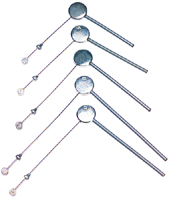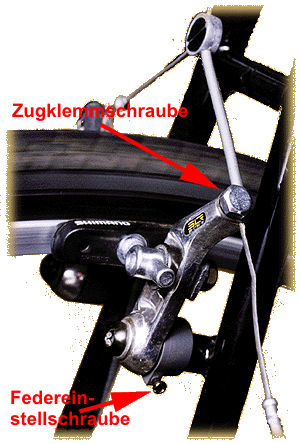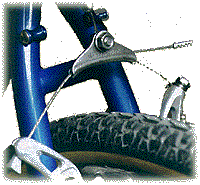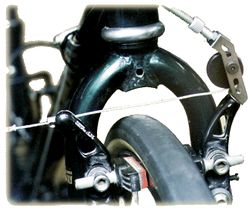Cantilever-Bremsen einstellen: Unterschied zwischen den Versionen
(→Zu hohe Hebelübersetzung: Bilder) |
(→Zentrieren: übersetzt) |
||
| Zeile 56: | Zeile 56: | ||
==Zentrieren== | ==Zentrieren== | ||
Wenn man die Bremse entspannt (also den Bremshebel loslässt), zieht sich der [[Bremsschuh]] von der [[Felge]] zurück. Idealerweise machen das beide Bremsschuhe auf beiden Seiten der Felge um den gleichen Umfang. Falls sie das nicht machen, ist die Bremse nicht ordentlich zentriert. Im Extremfall bewegt sich ein Bremsschuh gar nicht von der Felge weg und reibt an der Felgenflanke, ohne dass die Bremse betätigt wird. | |||
Wenn die Bremse nicht zentriert erscheint, sollte man zuerst das Laufrad auf korrekte Montage im [[Rahmen]] bzw. in der [[Gabel]] prüfen. Wenn das [[Laufrad]] schräg montiert ist und man die Bremse falsch einstellt, um das zu kompensieren, hat man jetzt zwei Probleme, wo man vorher nur eines hatte. | |||
Wenn die Bremse jedoch wirklich nicht zentriert ist, ist das häufig ein Resultat von zu viel Reibung auf einem der [[Cantisockel]]. Hänge den [[Querzug]] aus und bewege mit der Hand die Bremsarme einzeln. Sie sollten sich leicht und frei bewegen lassen und jedes mal an der gleichen Position landen, wenn man sie loslässt. Wenn Du Reibung vermutest, schraube den Bremsarm vom Cantisockel und entferne den Bremsarm. Die Oberfläche des Sockels sollte glatt, frei von Rost und mit [[Fett]]geschmiert sein. Falls er rostig ist, hat der Händler, der Dir das Fahrrad verkauft oder repariert hat, unsauber gearbeitet. Nimm Polierleinen oder Schmirgelpapier zur Hand, um den Rost zu entfernen und um Staub und Sand zu entfernen. Schmiere den Sockel mit Fett und montiere den Bremsarm wieder. | |||
==Einstellen der Federspannung== | ==Einstellen der Federspannung== | ||
[[Datei:Canti-shimano.png|right|Zugklemmschraube und Federeinstellschraube einer Shimano Cantilever Bremse]] | [[Datei:Canti-shimano.png|right|Zugklemmschraube und Federeinstellschraube einer Shimano Cantilever Bremse]] | ||
Version vom 11. Oktober 2016, 07:38 Uhr
Klassische Cantilever-Bremsen sind Felgenbremsen. Im Zusammenhang mit diesem Artikel solltest Du auch Das 1x1 der Felgenbremsen lesen. Dort werden unter anderem auch folgende Aspekte erläutert, die auf alle Arten von Felgenbremsen zutreffen:
- Warum Felgenbremsen?
- Typen von Felgenbremsen
- Zentrieren
- Hebelübersetzung
- Geräusche/Quietschen
- Typen von Bremsschuhen
- Einstellen der Bremsschuhe
Die meisten Probleme mit Felgenbremsen werden durch exzessive Reibung oder schlechte Montage der Züge verursacht. Schlechte Einstellung oder Bremsen geringer Qualität sind zumeist keine Gründe.
- Siehe auch
- Züge - über dir richtige Montage von Zügen und Bremshebeln.
Praktische Tipps zum Einstellen der Cantilever-Bremsen
Theorie und Praxis
Bei WikiPedalia findet sich ein recht theoretischer Artikel zur Cantilever Geometrie mit detaillierten Informationen zu verschiedenen Themen. Ein spezieller Fokus liegt dabei auf der Feinjustage der Hebelübersetzung dieser klassischen Cantilever-Mittelzug-Systeme.
In diesem Artikel hier liegt der Fokus auf praktischen Tipps, die mit Verweisen zu theoretischen Aspekten versehen sind. Damit sollten auch diejenigen auf ihre Kosten kommen, die die Theorie hinter der Praxis verstehen möchten.
Querzugträger oder Verbindungszug
Klassische Cantilever-Bremsen hatten zwei separate Züge. Es gab den Hauptzug, der vom Bremshebel zur Bremse verlief und den Querzug, der zwischen den beiden Cantilevern gespannt war. Der Hauptzug wurde am Querzugträder befestigt. Das war eine Art Haken, der den Querzug hochziehen konnte.
Diese Art der Cantilever-Bremse funktionierte so lange gut, bis Mountainbikes modern wurden. In dieser Zeit gab es einige harte Landungen, weil der Hauptzug gerissen ist. Der Zug riss am Bremshebel oder an der Umlenkrolle. Durch das plötzliche Versagen des Zugs, sprangen die Bremsarme auseinander und der Querzug blieb an einem Stollen des Reifens hängen, was unter Umständen zu einem sehr plötzlichen Stopp führte. Aua!
Als Antwort darauf erfand Shimano den Verbindungszug. Der Verbindungszug ersetzt den Querzugträger und eine Hälfte des Querzugs. Der Hauptzug wird durch den "Knopf", der als "Querzugträger" dient zu einem Bremsarm geführt und stellt die andere Hälfte des Querzugs dar.
Man sollte einen Reflektorhalter, ein Schutzblech oder andere Vorrichtung einsetzen, um den Querzug davon abzuhalten, in Kontakt mit dem Reifen zu kommen, falls der Hauptzug versagt. Auch mit einem Verbindungszug ist das immer noch ratsam. Man kann es selbst testen, was passiert, wenn man den Bremszug am Bremshebel aushängt.
Auf dem Knopf ist eine Vertiefung eingedrückt, in die man den erweiterten Hauptzug ausrichten soll.
Es gab anfangs einigen Widerstand gegen dieses Verbindungszugsystem, weil es nicht ganz so leicht einstellbar ist wie ein separater Querzugträger - man kann nur zwischen verschiedenen Verbindungszuggrößen wählen. Es ist jedoch ein Fakt, dass das Verbindungszugsystem dem Querzugträgersystem überlegen ist. Anders als bei klassischen Querzügen, bei denen der Querzug über den Querzugträger gebogen ist, auch wenn die Bremse entspannt ist, sind beim Verbindungszug alle Züge gerade. So werden unnötige Bewegungen vermieden und die Bremse lässt sich leichter einstellen.
Verbidungszüge gibt es normalerweise in fünf Längen:
| Kodierung | Länge | |
|---|---|---|
| S | 63 mm | |
| A | 73 mm | |
| B | 82 mm | |
| C | 106 mm | |
| D | 93 mm |
Zentrieren
Wenn man die Bremse entspannt (also den Bremshebel loslässt), zieht sich der Bremsschuh von der Felge zurück. Idealerweise machen das beide Bremsschuhe auf beiden Seiten der Felge um den gleichen Umfang. Falls sie das nicht machen, ist die Bremse nicht ordentlich zentriert. Im Extremfall bewegt sich ein Bremsschuh gar nicht von der Felge weg und reibt an der Felgenflanke, ohne dass die Bremse betätigt wird.
Wenn die Bremse nicht zentriert erscheint, sollte man zuerst das Laufrad auf korrekte Montage im Rahmen bzw. in der Gabel prüfen. Wenn das Laufrad schräg montiert ist und man die Bremse falsch einstellt, um das zu kompensieren, hat man jetzt zwei Probleme, wo man vorher nur eines hatte.
Wenn die Bremse jedoch wirklich nicht zentriert ist, ist das häufig ein Resultat von zu viel Reibung auf einem der Cantisockel. Hänge den Querzug aus und bewege mit der Hand die Bremsarme einzeln. Sie sollten sich leicht und frei bewegen lassen und jedes mal an der gleichen Position landen, wenn man sie loslässt. Wenn Du Reibung vermutest, schraube den Bremsarm vom Cantisockel und entferne den Bremsarm. Die Oberfläche des Sockels sollte glatt, frei von Rost und mit Fettgeschmiert sein. Falls er rostig ist, hat der Händler, der Dir das Fahrrad verkauft oder repariert hat, unsauber gearbeitet. Nimm Polierleinen oder Schmirgelpapier zur Hand, um den Rost zu entfernen und um Staub und Sand zu entfernen. Schmiere den Sockel mit Fett und montiere den Bremsarm wieder.
Einstellen der Federspannung
If your wheels are centered, and your brakes are not, and, if the pivots are properly lubricated and free-moving, the brake shoes should be centered. If they are not, you probably need to adjust the spring tension on one or both of the cantilevers. Different brands of cantilevers feature different systems for adjusting the springs.
- Spring attachment. Most cantilever bosses on newer bicycles have a series of 3 small holes next to the boss itself. These holes are meant to receive and anchor the end of the return spring. Depending on which of the holes you chose to put the spring into, you have a coarse adjustment of the spring tension. The top hole provides the highest tension, the bottom hole the lowest. For most installations, the middle hole is best. (Some bosses only have one hole.) Both sides should use the same position.
- Shimano style cantilevers usually have a small screw on one of the cantilevers for fine balancing. This is usually on the left side of the front brake, the right side of the rear. In the early '90's, this adjustment required a 2mm Allen wrench, but newer models use a Phillips screwdriver.
- Dia Compe style cantilevers often use a totally different approach. The Dia Compe system doesn't use the spring hole in the cantilever boss, but has a separate spring block as part of the cantilever assembly. This spring block is the first part to go onto the boss, and it has a hole for the end of the spring. When the bolt holding the cantilever to the boss is loose, the spring block can turn freely, but when this bolt is tightened, it locks the spring block in place. The spring block has flats for a cone wrench (usually 13 mm) to let you rotate it to provide the desired tension.
- Some Dia Compe style brakes have these adjustable spring blocks on both sides, others have one only on one side, with the other side using the normal spring holes in the boss.
- Note: Brakes which use the adjustable spring block do not use the cantilever boss as a bearing surface; instead, they have a hollow cylindrical bushing (sleeve) which fits over the boss. The outside of this bushing/inside of the cantilever must be greased, as you would normally grease the boss.
- Non-adjustable springs are found in older or cheaper cantilevers. If these need adjustment, you must physically deform them. You can sometimes increase the tension of the spring by unhooking the transverse cable and forcing the cantilever out much farther than it would normally go. If that doesn't work, you may need to slide the brake shoe in or out of the eyebolt to adjust clearance.
Hebelübersetzung
Unlike most other types of brakes, cantilevers permit different setups which provide more or less mechanical advantage. Mechanical advantage is a key concept, which you must understand before you will be able to fine-tune your cantilever brakes. Mechanical advantage is commonly referred to as "power", when discussing brakes, and it is common for people to confuse this with quality. A brake may be designed for any amount of mechanical advantage, but there is a fairly narrow range that is useable.
Zuviel oder zu wenig Hebelübersetzung?
People with brake problems often think that they need more "power," when they actually need less! In particular, when modern low-profile cantilever brakes are used with drop-bar type brake levers, the combination produces excessive mechanical advantage. This problem also arises when using direct-pull cantilevers (such as Shimano's "V-Brakes") with levers made for conventional center-pull cantilevers.
Zu wenig Hebelübersetzung
If you have too little mechanical advantage, when you squeeze your brake handles, you will feel a nice firm response. In fact, if you just squeeze the brakes of a bike that is not moving, your first impression may be that the brakes are in great shape, because they feel so solid and firm...the problem is, that they don't stop the bike, unless you squeeze very hard on the levers!
A brake system with too little mechanical advantage will push the shoes against the rim quickly, but won't push them hard enough. The levers will feel firm because the shoes are not being pressed hard enough to cause them to flex.
If you have too little mechanical advantage, lowering the cable yoke so that the transverse cable is more nearly horizontal will help. If you have low-profile cantilevers, artificially "widening" the profile will also increase mechanical advantage: set the transverse cable wide enough that the shoes have to be exended inward on their bosses to reach the rim.
In some cases, what appears to be inadequate mechanical advantage turns out to be that the brake shoes are not "grippy" enough; they may be dirty, or dried out, or of low quality. Better-quality shoes can make a real difference. I particularly recommend Kool-Stop Salmon brake shoes, which have good grip and wear slowly.
Zu hohe Hebelübersetzung
If you have too much mechanical advantage the lever will be all-too-easy to pull, but it will run out of travel and bump up against the handlebar before the brake is fully applied. Once the lever hits the handlebar, it doesn't matter how much harder you squeeze! If you try to correct this by tightening up the cable, you will wind up with the brake shoes too close to the rim when at rest, which will cause them to rub, especially if the wheel isn't perfectly true. Excessive mechanical advantage can often be reduced by raising the cable yoke and lengthening the transverse cable, so that it makes a sharper angle around the yoke. Unfortunately, there isn't always room to raise the yoke far enough, especially in the rear of smaller frames.
A special wide yoke sometimes helps with this. It causes the transverse cable to run at a sharper angle than it would with a conventional yoke.
If you have too much mechanical advantage, as with a touring bike or tandem with drop-bar-type levers, you can, in some cases, use a pulley adaptor to convert your conventional cantilevers into direct-pull units. Note however that a pulley will result in fatigue failure of the cable sooner or later, so check it frequently.
Variable Hebelübersetzung
Mechanical advantage can vary as the brake is squeezed.
Ideally, it should start out low, so that the brake shoes can be set for generous rim clearance. The low initial mechanical advantage will allow the shoes to move in toward the rim fast, in response to a small amount of hand-lever movement.
As the shoes get close to the rim, the mechanical advantage should increase, so that a small amount of hand force will result in a strong force pressing the shoes against the rim.
Some high-end brake levers, most notably the upper-end Shimano models with the "servo-wave" feature, are designed to do exactly this.
Unfortunately, conventional center-pull cantilevers prouduce exactly the opposite variation! As the lever is pulled, the yoke angle gets sharper and sharper, while, in the case of a low-profile model, the pivot-cable distance decreases. Both of these conditions reduce the mechanical advantage as the brake is applied.
Since the travel increases as the brake shoes wear down, braking performance degrades as the shoes wear, not because the shoes have any less grip, but because the mechanical advantage has decreased.
Quelle
Dieser Artikel basiert auf dem Artikel Adjusting Traditional Center Pull Cantilever Bicycle Brakes von der Website Sheldon Browns. Originalautor des Artikels ist Sheldon Brown.



